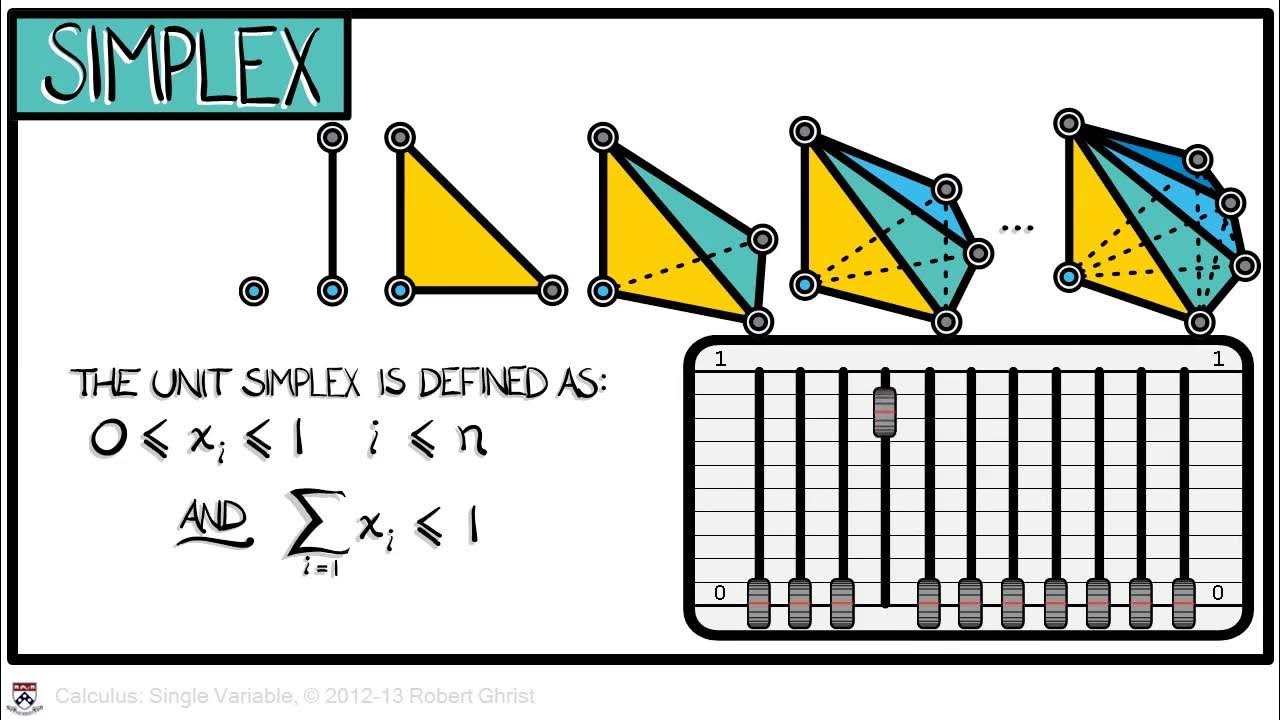Calculus Chapter 4 Lecture 42 Fair Probability
TLDRIn this calculus lecture, Professor Greist explores the intersection of probability and geometric concepts. Starting with basic probability through dice rolls, the lecture delves into calculating chances using geometric figures like circles, squares, and balls in various dimensions. The 'Buffon's needle problem' highlights the use of integrals to find the probability of a needle crossing parallel lines. The surprising conclusion about high-dimensional volumes and the potential to approximate pi through needle drops adds a layer of intrigue to this foundational lesson on fair probability and uniform distributions.
Takeaways
- 🎲 The script introduces probability through a geometric perspective, emphasizing the visual and visceral nature of the subject.
- 📊 Probability begins with counting, illustrated by rolling a pair of dice and calculating the probability of the sum being greater than 7.
- 📈 An integral can be hidden within simple probability problems, as hinted by the lecturer, suggesting a deeper mathematical structure.
- 🎯 The concept of computing probabilities by considering angles and lengths, as in the example of spinning a dial, is introduced.
- 📏 The probability of a randomly chosen angle having a sine greater than 1/2 is calculated by considering the length of the circle's arc.
- 🔍 The script discusses the use of area to determine the probability of a randomly chosen point in a square lying within an inscribed circle.
- 📐 The importance of volume in calculating the probability of a randomly chosen point in a ball being within the outer 1% of the boundary is highlighted.
- 🧩 The surprising result that in high-dimensional spaces, most of the volume of a ball is concentrated near its surface is revealed.
- 📘 The script explains the concept of fair probability or uniform probability distribution, relating it to the volume fraction of a subset within a domain.
- 📍 The classic 'Buffon's needle problem' is used to demonstrate the calculation of probability involving both independent variables and integrals.
- 📉 The approximation of pi using the Buffon's needle problem is suggested, providing an interesting real-world application of the discussed concepts.
Q & A
What is the main topic of Professor Greist's lecture 42?
-The main topic of the lecture is the introduction to probability, with a focus on geometric treatment, visual and visceral understanding, and the application of concepts from averages, moments, and centroids in the context of probability.
How does the script begin the discussion on probability?
-The script begins the discussion on probability by starting with counting, specifically using the example of rolling a pair of dice and calculating the probability of the sum being greater than 7.
What is the probability of rolling a sum greater than 7 with a pair of dice?
-The probability is 15 out of 36, which is a little less than 50/50 chance.
What is the significance of the integral in the context of the dice example?
-The significance of the integral in the dice example is hinted at as a potential mathematical tool that could be used to approach probability problems, although it is not explicitly calculated in the script.
How does the script explain the concept of computing probability using angles?
-The script explains the concept by considering a situation where a dial is spun, and the probability of a win is computed by considering the angles as lengths and taking the ratio of winning angles to the total number of angles.
What is the probability that a randomly chosen angle on a circle has a sine larger than 1/2?
-The probability is 1/3, computed by taking the ratio of the length of the angles with sine larger than 1/2 (which is 2π/3) to the total length of the circle (2π).
How does the script relate the probability of a randomly chosen point in a square lying within an inscribed circle to the concept of area?
-The script relates it by considering the area fraction, taking the area of the inscribed circle (πr^2) and dividing it by the area of the square (2r)^2, resulting in a probability of π/4 or about 79%.
What is the probability of a randomly chosen point in a ball being within the outer 1% of the boundary as measured by radius?
-The probability is about 2.97%, computed by taking 1 minus the ratio of the volume of the inner 99% ball (0.99^3) to the volume of the full ball (1).
How does the script illustrate the concept of high-dimensional volume in the context of an n-dimensional ball?
-The script illustrates it by showing that as the dimension n increases, the probability of a randomly chosen point being within the outer 1% of the boundary approaches 99%, emphasizing the concept of high-dimensional volume concentration.
What is the Buffon's needle problem discussed in the script, and how is it solved?
-Buffon's needle problem involves dropping a needle of length L onto a plane with parallel lines separated by distance L and determining the odds of the needle crossing a line. It is solved by setting up a geometric probability model using calculus to compute the area fraction under the curve of L * sin(theta) within a rectangle defined by H and theta.
How does the script connect the probability of the Buffon's needle problem to the approximation of pi?
-The script connects it by noting that the probability of the needle crossing a line is 2/π, suggesting that by dropping needles and counting the number of crossings, one could approximate the value of pi by taking the reciprocal of this probability and multiplying by two.
What does the script suggest about the nature of probability and its relation to future lessons?
-The script suggests that probability is a somewhat mysterious subject and hints that future lessons will explore more complex scenarios, including不公平 (unfair) situations where the underlying probability distribution is not uniform.
Outlines
🎲 Introduction to Probability with Dice Rolls
Professor Greist begins lecture 42 on probability by introducing the concept through a geometric approach. He uses the example of rolling two dice to explain how to calculate the probability of the sum being greater than 7. By creating a table of all possible outcomes and identifying those that meet the condition, he demonstrates that the probability is the ratio of favorable outcomes to total outcomes, which in this case is 15 out of 36, or slightly less than 50%. The lecture hints at the presence of an integral within this simple scenario and encourages students to stay tuned for further insights.
📏 Geometric Probability Involving Length, Area, and Volume
The lecture continues with an exploration of geometric probability, starting with spinning a dial and transitioning to more complex examples involving angles, circles, and regions within squares and balls. The professor illustrates how probability can be calculated using ratios of lengths, areas, or volumes, depending on the context. For instance, the probability of a randomly chosen angle on a circle having a sine greater than 1/2 is derived by comparing the length of the relevant angles to the total circumference (2π), resulting in a probability of 1/3. Similarly, the probability of a randomly chosen point in a square lying within an inscribed circle is found by dividing the area of the circle (πr²) by the area of the square (2r)², yielding a probability of π/4 or approximately 79%. The lecture also touches on the concept of high-dimensional volumes, leading to the surprising result that in high-dimensional spaces, most of the volume of a ball is concentrated near its surface.
🧩 The Buffon Needle Problem and Its Implications
The third paragraph delves into the Buffon needle problem, a classic example of geometric probability involving both independent variables and integrals. The problem involves dropping a needle of length L onto a plane with parallel lines spaced L apart and calculating the probability that the needle crosses one of the lines. The professor explains how to characterize the position of the needle using variables H (horizontal distance from the needle's tip to the nearest line) and θ (the angle the needle makes with the line). By setting up a right triangle and using the inequality L * sin(θ) ≥ H, the probability of the needle crossing a line is determined as an area fraction under the curve of L * sin(θ) within a rectangle bounded by θ from 0 to π and H from 0 to L. The integral calculation leads to a probability of 2/π, which intriguingly includes the value of π and suggests a method for approximating π by dropping needles on a grid of lines.
🔮 Fair Probability and the Exploration of Non-Uniform Distributions
In the final paragraph, the professor discusses the concept of fair probability, or uniform probability distribution, where the likelihood of a random point falling within a subset of a domain is determined by the volume fraction. This concept is applied to various geometric shapes and spaces, emphasizing that the type of 'volume' considered (length, area, volume, or hyper-volume) depends on the dimension of the domain. The lecture concludes with a teaser for the next lesson, which will explore non-uniform probability distributions and the need to combine volumetric approaches with mass-based approaches from previous lessons.
Mindmap
Keywords
💡Calculus
💡Probability
💡Geometric Treatment
💡Random Variable
💡Integral
💡Volume Fraction
💡High Dimensional Volume
💡Uniform Probability Distribution
💡Buñuel Needle Problem
💡Convergence
Highlights
Introduction to probability using geometric treatment for a visual and visceral understanding.
Probability begins with counting, illustrated through the example of rolling a pair of dice.
Calculating the probability of the sum of two dice being greater than 7 using a table of outcomes.
The concept of integrals hiding within simple probability problems.
Using angles to compute the probability of winning in a spinning dial scenario.
Exploring the probability of a randomly chosen angle on a circle having a sine larger than 1/2.
The use of area to determine the probability of a point landing within an inscribed circle in a square.
Calculating the probability of a point in a ball being within the outer 1% of the boundary using volume.
The surprising result that in high dimensions, most of the volume of a ball is in the outer shell.
The concept of fair probability or uniform probability distribution over a domain.
The classical Buffon's needle problem and its relation to approximating the value of pi.
The use of calculus to solve the Buffon's needle problem by considering the area under a curve.
The probability of crossing a line with a needle being expressed as an area fraction.
The integral calculation leading to a probability of two over pi in the Buffon's needle problem.
The potential for approximating pi by dropping needles on a field of lines.
The mysterious nature of probability and its deeper exploration in future lessons.
The transition to considering unfair probability distributions and their impact on volumetric approaches.
Transcripts
Browse More Related Video

Lecture 12: Buffon's Needle or Pi from Breadsticks

Lecture 2: Interesting problems in probablity

Calculus Chapter 4 Lecture 43 Probability Densities

Session 40 - Probability Distribution Functions - PDF, PMF & CDF | DSMP 2023

Ultimate Probability Review for AP Statistics to Score a 5

Calculus Chapter 4 Lecture 34 Volume & Dimension
5.0 / 5 (0 votes)
Thanks for rating: